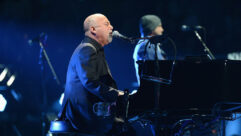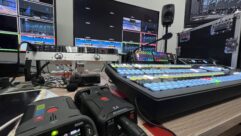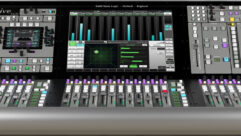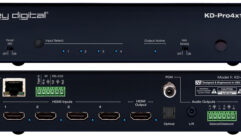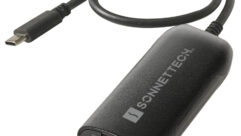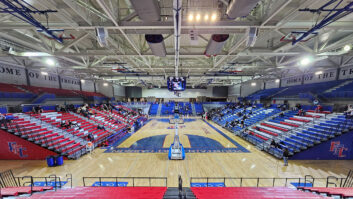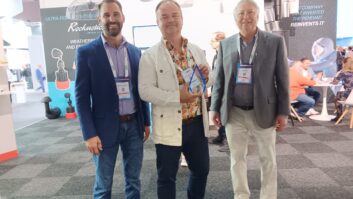
Live Mixing Know-how from Buford Jones, Part 2
Jul 16, 2014 1:23 PM,
With Bennett Liles
Listen to the Podcasts

Editor’s note: For your convenience, this transcription of the podcast includes timestamps. If you are listening to the podcast and reading its accompanying transcription, you can use the timestamps to jump to any part of the audio podcast by simply dragging the slider on the podcast to the time indicated in the transcription.
In mixing live sound, there’s no substitute for experience, and we have a guest who’s mixed with all the greats. Buford Jones with Meyer Sound is back to tell us more about how it’s done, digital and analog boards, and working with in-ear and floor monitors from a guy who has done it all. Coming right up on the SVC Podcast.
Buford Jones of Meyer Sound, thanks for being back with us for part two on live mixing at the front-of-house. In working with the big names in music in live performance, you’ve used a lot of different types of hardware and consoles. There’s still a lot of analog gear around. Is there still a place for that? I mean, what are the pluses and minuses of, say, analog versus digital?
I think coming from an old school—I’ve been out there for years—we’re certainly reluctant to go to the digital mixers, mainly for the computing aspects of it. You go, “Oh well, this thing’s fundamentally operating on the computer. It might crash on me,” and I’m a little scared to go there. I’ve had many analog desks crash on me in a different way, but they crash too. Any time we’re relying totally on electronics there could be failure, but at the same time, there are so many advantages to the digital consoles. In fact, just recently talking to several sound company owners, three and four years ago they were already saying they had well surpassed 50 percent inventory of digital consoles, so it’s here to stay. Some of us that cling to the analog consoles I certainly understand. That’s your comfort zone and that’s really good. There’s always a sonic argument of digital versus analog. Well, I think with the bit depth and sample rates—the advancements we’ve had in that—it’s just getting pretty hard to detect the differences, and I think with the mixing style of the engineer, it’s almost undetectable. So it depends on the artist and our approach on the mix, but the flexibility that a digital console gives us is just amazing. I think 30 years ago, to have had some sort of futuristic discussion about what digital consoles offer us today, we’d say, “No way.” We can’t even imagine that. I mean just to have gains and compressors on every input, to be able to record within the console. We have analyzers in the console. To be able to just recall scenes, it just goes on and on; the flexibility that it gives us in the reduced amount of real estate that we’re taking up in front of house. It’s so great to have these big racks eliminated and everything is right in the console itself. Therefore, I think the effectiveness of our efforts to pull the mix together we can do it much faster. I think the layering is the only thing that kind of bothers me a little bit that I’m still getting used to. I think by bouncing up and down the layers, you add that time up during a concert, and it would add up quite a bit. [It’s] not a problem, but all the other aspects, it’s just a tremendous flexibility that we have under our fingertips and therefore, our consistency level that I talked about earlier is dramatically increased. I believe the overall sound we’ve been able to achieve that night to night is a very useful advantage. [Timestamp: 3:39]
I think the last big argument for analog was price and that’s certainly not the case anymore.
That’s right. That’s certainly changed recently too.
I know that when you’re working with these things it depends on the type of music and the personalities of the performers, but do you find that monitor levels tend to creep up during sound checks and live shows?
They certainly do. That’s just an excitability thing or an adrenaline. I hope that we can nail that in. I’ve heard some [artists] say at sound check, “Do you want us to play at sound check volume or show volume?” I almost don’t believe you’re asking me that. Of course we want show volume, the sound engineers do. It has to do with the gain structure of the console and it’s how clean the signals are. But I find that most of the time it’s not so completely out of hand that it’s impossible to deal with. There is going to be some changes in levels and that’s just the spontaneity of it all. I think walking out in front of that audience and then I think sometimes we tend to turn up the PA a little bit. The engineer does the same thing. You might crank it up a little bit because well, you’re just excited now and you want to drive a little bit harder, which is not really the answer. It’s not helping you, but we just tend to want to do that. I think most of us felt if there’s anything we can improve on something in sound it’s turning it up and that’s a myth. That’s not the case. I think there’s some devices and plug ins that we can put on and if our result is a little bit louder than our input, well, then we feel like, “Oh, this sounds good. This is doing something good for us.” I think we’re misled by that many times. We’ve just got to kind of cope with that and work with that the best you can. But I think with the good communication we talked about earlier with the artist, you will be able to keep within some boundaries there and they’ll understand that. [Timestamp: 5:27]
Live Mixing Know-how from Buford Jones, Part 2
Jul 16, 2014 1:23 PM,
With Bennett Liles
Well of course we can talk about how to treat performers and the artistic side of the job, but sometimes there are more basic problems like when you bring up the fader and something is humming or buzzing. Do you ever get into having to isolate audio power from lighting or things like that?
I can remember that in the early years, every once in awhile we’d have to deal with that and of course, leaving it up to professionals and people that are trained in that area working with electrical components to remedy those situations when they occur. But, you know, that’s an interesting question. I’m wondering that if in the digital domain, I have not really been aware of that as much as it used to be. We’d hear it every so often and have to work with that, have to work with the stage technicians. You could generally tell if you have multiple inputs that are humming, we can figure out that, yeah, the source they see is the problem. But on individual channels I think it’s just where we occasionally hear it as just a matter of really proper grounding of the system that a guitar player is working with, for instance. But I think most of us have pretty good grounding concepts. I think it doesn’t seem to be that much of an issue as I remember in the past, and it wasn’t that tremendously bad then. But it’s something that did occur once in awhile and you needed to cope with it. [Timestamp: 6:43]
What about the instruments themselves? Do you get challenged by having to mix certain types of instruments on a live show?
Yeah, of course, acoustic instruments. You know, electronic DIs have always spoke for itself. I kind of always prefer it if I can. That’s like miking the bass guitar versus the DI. A lot of times we’ll take both, but I find myself always really going back to the DI. I could do more with the DI, I think, in getting the sound of the bass guitar that I’m after. But at the same time, I think a guitar amplifier needs that natural distortion of the transducer to be apart and compliment the guitar sound. I think taking the direct off the guitar is not so good. Now acoustic instruments—acoustic guitars, acoustic pianos—have always been a much more challenging area to reproduce. For a long time the grand pianos—we still see grand pianos in the touring world onstage night to night, and this is particularly difficult. Some tours would carry their own pickups and different devices that could be mounted into the piano. Usually a pretty stable sound, but it was still, I don’t think, quite acoustically correct. It was very hard to achieve that natural sound, but some of those instruments were not ever designed to perform in that loud musical stage, meaning that being the environment. When you’re trying to reproduce that in high level, it’s difficult. I’m talking about a grand piano. I’m talking about a horn section or what have you. If it’s on a loud stage, it’s a little bit more difficult to get out. Acoustic guitar, very difficult to get out because when I mic them, I like to mic those instruments in a natural miking position, really closer to what a musician hears himself. I talk about this in my mix workshops sometimes and just illustrate what I’m talking about in miking positions. When you are able to mic it more than what a musician hears it, I think it tends to be a more natural sound and that way we can reproduce it. But your gain before feedback is an issue in some cases for trying to reproduce that sound and amplify it quite a bit. [Timestamp: 8:51]
Working at the front of house, do you notice a big difference working with bands that use only in-ear monitoring and working with acts that use mainly floor wedges?
Oh, I think front-of-house engineers have preferred in-ear monitoring ever since they’ve come out. It gives us a lot more control of our mix. I think, too, the floor wedges in not only in cleaning up the stage sound and removing just a lot of additional sound levels that are just, well, they’re just almost in chaos. They’re going every different direction. It’s a lot of sound generated on the stage. When we go to the in-ear monitors, it reduces that a lot and tightens it up for the front-of-house mixer. I think another part that has I think improved [is] monitors. When I think of monitors there are two main reasons why they exist and one is to help the musician stay in pitch and also to stay in time. With in-ears I think they’re able to accomplish that a lot quicker. If I hear singers sing off pitch, it’s almost, nine times out of 10, when I ask them after their show, “Did you have difficulty hearing the monitors tonight,” and they’ll say, “Yes.” So that could be very difficult in some situations, and to get them what they need or it may be variables and the result is singing off pitch and a little bit off time. So in-ears have certainly improved that and for front of house and their mix. [Timestamp: 10:15]
What about when they’re just having a bad night and you’ve got a vocalist who is not feeling well or is just not sounding good? What do you do at the front of house or what can you do out there to try and make it easier for them?
Well, another good question and very debatable, or at least my answer is going to be. There’s a certain point, I like to think I can produce a show and that I can be a musical director, too, at the same time, but I’m really the sound mixer. It’s my job to balance what I see and also to do it within that musical formula that I spoke of earlier that the artist has created. Not because somebody’s singing maybe slightly off pitch; I’m not going to tend to put them over in the mix. I think that is a decision, really, of a producer or arranger that listens to recordings more so and then can deal with the singer or we can also work together for the monitoring situations if that’s what they need there. It’s very frustrating to me to look at musicians, see them going through the motions, but me not hearing them. That’s frustrating to me. I’d rather hear them.I think slight pitch problems are natural. It’s all part of natural live performance. You don’t expect it to be so robotic and perfectly pitched. If it is, great; it’s all the better, but I’m not going to try to change my mix again and alter people in the balance of the mix if they’re not quite singing on pitch. [Timestamp: 11:37]
You’ve worked with so many big name and lesser-known performers. Have you had anything really crazy happen during a live show?
Well, sure. If you have another hour or two we can go on lots of those. In recent memory, I think that something I go back on, we’ve seen some artists that like to really control the sound from what they hear on stage and that is an unusual mixing situation. I’ve actually seen it a couple of times where the artist completely dictated what they heard from the stage to the sound mixer and expected that to be mixed from up there and it’s a whole different viewpoint. It’s something that really cannot be accurately done. It’s like walking behind a speaker cabinet and expecting to hear the full range that you would in front of the speaker cabinet. Well, you might on the low frequencies, but you certainly aren’t on the high frequencies, so it’s a completely different; we can’t judge doing that. There are some things, I know, in controversy and one thing I do talk about in my mix workshop that has to do with linearity and scalability of systems is a time period where I did remote mixing. I just recently, in fact, did a webinar and had a guest and he’s been doing it with some major artists recently. It’s not something I promote at all, but you’re asking unusual mixing situations and what we do is you can mix in isolation. It’s not for every job or music; it’s not for every artist. In some cases it would not work whatsoever, but there’s some that it will. If you control the stage volume and you control the stage levels and everything is in-ears, I have done this to quite a very good success multiple times. I’m talking about 60, 70, 80 shows and mixing in isolation. I was trying to achieve consistency is what I was doing when I did that, but some would consider that very unusual. That means not being in the house that the concert had been performed in and you’re mixing either backstage or outside in a vehicle or whatever. But it can be done. It can be done. But that will take us a lot more time to discuss that at another time when we can possibly talk about that. [Timestamp: 13:48]
Buford, you’ve also seen a lot of changes in the gear over the years from analog to digital and I appreciate your telling us about what goes on at the main house console. Buford Jones from Meyer Sound and the real action job, the front of house sound mixer. Thank you for stopping by for us.
It was absolutely my pleasure, Bennett. I’ll be glad to be of assistance any time and join you again. I wish you the best on your program.


